- Home
- Knitting Stitches for Beginners
- Knit and Purl Stitches
- Flying Geese Knit Stitch Pattern
- Feather and Fan Knitting Pattern
Feather and Fan Knitting Pattern: Tutorial, Tips, Ideas
Feather and Fan Knitting Pattern by Janice Jones
The Feathers and Fan stitch, or the Wave stitch, is a beautifully textured pattern that creates a mesmerizing wave-like effect in your knitting. It's surprisingly simple to execute, making it suitable for knitters of all skill levels.
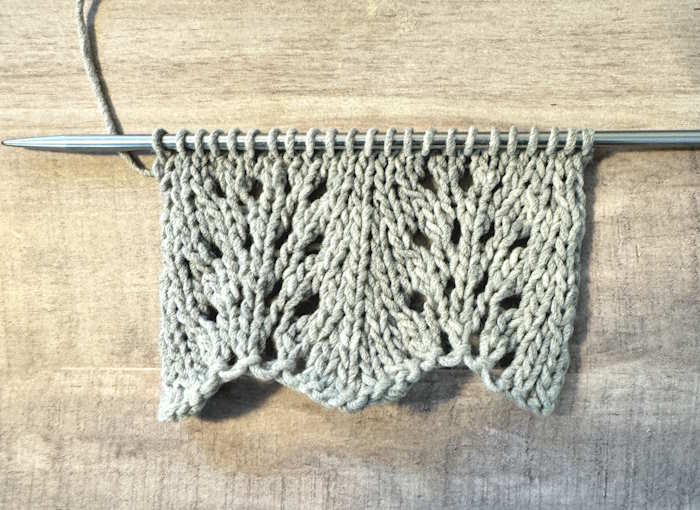
A Little History
While its origins remain unclear, the Feathers and Fan stitch has graced knitting needles for decades. Some believe it originated in the Shetland Islands, known for their intricate lace knitting traditions.
The Feathers and Fan stitch, in various forms, appears in knitting pattern books dating back to the early 1900s. While specific attribution is often missing, these books suggest the pattern was already circulating widely. It's often found in vintage knitting books and patterns, proving its enduring appeal.
Feathers and Fan vs. Old Shale
The Feathers and Fan stitch is often confused with the Old Shale stitch. While they share a similar visual rhythm, a key difference sets them apart:
Feathers and Fan: Uses a combination of yarn overs and decreases to create pronounced peaks and valleys.
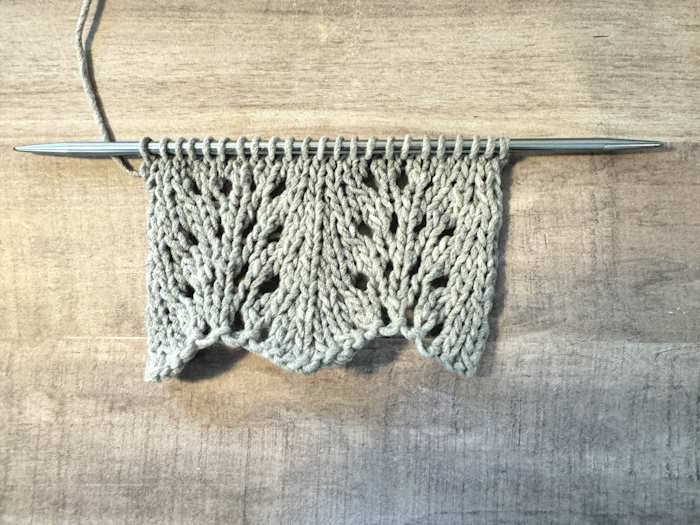 Feather and Fan Knit Pattern
Feather and Fan Knit PatternOld Shale: Achieves a subtler wave effect by working stitches through the back loop and utilizing slipped stitches.
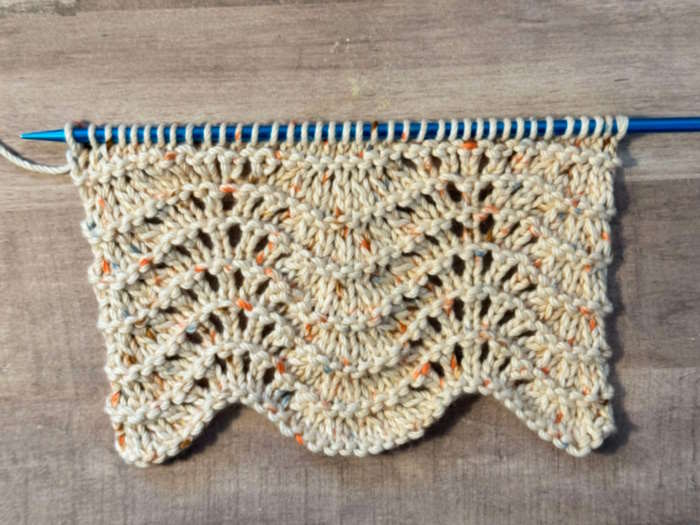 Old Shale Lace
Old Shale LaceWorking the Feather and Fan Knitting Pattern
While researching for this page, I got increasingly confused by all the published variations that exist calling themselves Feather and Fan.
I weeded out all of those that were actually the Old Shale and was left with several different variations that basically created similar fabric.
Materials Needed for Feather and Fan Knitting Pattern
To knit the feather and fan pattern, you will need a few basic materials, including:
- Yarn: You can use any type of yarn for this pattern, but it looks best with a lightweight yarn, such as fingering or DK weight. For the purpose of this tutorial, I used a 100% cotton yarn.
- Needles: You will need knitting needles in the appropriate needle size for your yarn or one size larger. (I used size US 8 (5.0 mm) knitting needles.
- Stitch markers: These are optional but can help mark the beginning and end of each pattern repeat.
- Tapestry needle
- Scissors
Abbreviations Used in Feather and Fan Pattern
- k: knit
- p: purl
- k2tog: knit two stitches together.
- yo: yarn over
- rep: repeat
- st(s): stitch(es)
- RS: Right Side
- WS: Wrong Side
- * * pattern repeats
Notes and Suggestions
- All instructions are written in US terms.
- For best results, count your stitches after row 1 to assure you maintain the correct number. It's easy to forget a Yarn over and end up with fewer stitches than is required.
- Try to keep your tension even so that all the "holes" made by the yarn overs are even.
Feather and Fan Variation Number 1
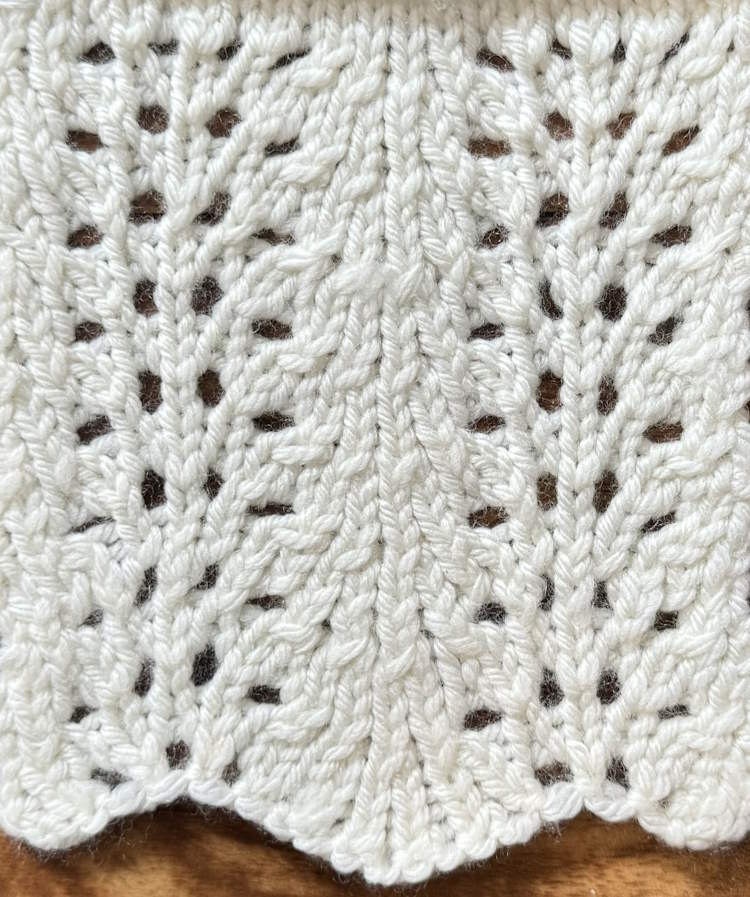
I found this first variation in a Craft Yarn Council Handbook. I added two stitches to each row, one on either side to act as edge stitches.
Instructions
Cast on Multiples of 11 plus two.
For this swatch, I cast on 24 stitches.
Row 1 (RS): K1, K2tog twice, *(YO, K1) 3 times, YO, K2tog 4 times; Repeat from * to the last 8 sts, then (YO, K1) 3 times, YO, K2tog twice, K1.
Row 2: Purl
Row 3: Knit
Row 4: Purl
Repeat rows 1 through 4 for the pattern.
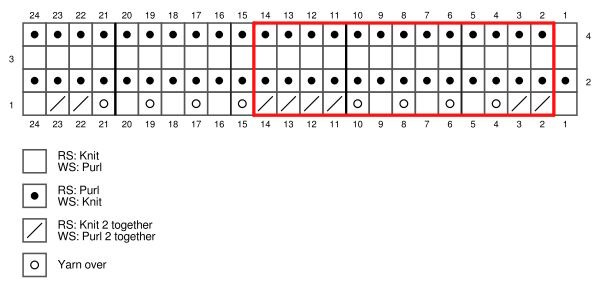
Feather and Fan Variation 2
The website, Northern Lace provides a good history and explanation for the many different types of Shetland Lace produced in the last century and before. This is the pattern that was offered on this site:
Using this stitch pattern, You would cast on in multiples of 14 stitches. Again, I added two to this number, one for each end of the row to be used as edge stitches.
Row 1: *K4tog, YO, (K1, YO) five times, K4tog tbl, P1. Repeat from *, ending with a K1.
Row 2: Knit
Please Note: This is not an easy pattern to knit due to the K4tog, so I can't recommend it.
Feather and Fan Variation 3
This version uses a multiple of 10 stitches + 5.
Row 1 (RS): Knit.
Row 2 (WS): Purl.
Row 3: *K2, yo, k2tog tbl, ssk, yo, k1, yo, ssk, k2tog tbl, yo, k2*. Repeat from * to * to the last stitch, k1.
Row 4: Purl
Repeat these four rows for the pattern
Working From a Chart
This lace pattern is relatively straight forward, however, if you prefer a chart, I've provided one below.
Common Mistakes When Knitting Feather and Fan Patterns and Tips to Consider
While the feather and fan pattern is relatively easy to knit, there are a few common mistakes that can trip up even experienced knitters. Here are some tips to help you avoid these mistakes:
- Make sure you are following the pattern correctly. The feather and fan pattern can be easy to get lost in, so it's important to stay focused and keep track of where you are in the pattern.
- Pay attention to your tension. The pattern is meant to be loose and airy, so make sure you are not knitting too tightly.
- Count your stitches regularly. It's easy to accidentally add or drop stitches when working this pattern, so make sure you are counting regularly to ensure you have the correct number of stitches.
- Learn to read your stitches so you know what a k2tog or a YO looks like.
- Experiment with colors: Consider using different colors for your Feather and Fan pattern by color changes every few rows or using a variegated yarn. Ombre yarns work especially well with this knitting pattern.
Feather and Fan Knitting Pattern Ideas
If you're looking for some inspiration for your next feather and fan knitting project, here are a few free pattern ideas to get you started:
- Feather and Fan Shawl: This pattern is perfect for showcasing the unique wave-like design of the feather and fan pattern. It is worked in a lightweight yarn and features a simple garter stitch border.
- Feather and Fan Baby Blanket: This pattern is perfect for a new baby or as a gift for a baby shower. It is worked in a soft, washable yarn and features a simple feather and fan pattern.
- Feather and Fan Scarf: This pattern is a great way to add a touch of elegance to your winter wardrobe. It is worked in a warm, bulky yarn and features a simple garter stitch border.
Feather and Fan Stitch Pattern Swatches
Stitch pattern swatches are an excellent way to practice the Feather and Fan pattern and understand how it looks with different yarns and needle sizes. Many beginning knitters dread the thought of creating swatches, but that is really the best way to learn and cement the pattern onto your brain!
- Swatch with worsted weight yarn: This swatch will show you how the pattern looks with a medium-weight yarn and how it affects the overall fabric. It’s the easiest for beginners, and you can view your stitches much easier with a number 4 worsted-weight yarn.
- Swatch with fingering weight yarn: This will demonstrate the Feather and Fan pattern's delicate nature when working with lightweight yarn. This is a good choice if you want to try your hand at making a lightweight summer shawl.
- Swatch with different needle sizes: Experiment with different needle sizes to see how they affect the final fabric and stitch definition. Your gauge will differ depending on the size of your needles and the weight of your yarn.
Feather and Fan Knitting Pattern
Pin for Future Reference
Conclusion and Final Thoughts
The feather and fan knitting pattern is a classic stitch pattern that has stood the test of time. It is easy to learn, versatile, and creates a unique and elegant design perfect for various projects.
Whether a beginner knitter or an experienced pro, the feather and fan pattern will surely become a favorite in your knitting repertoire. So grab your needles and yarn and give it a try!
About Janice
I've been kniting and crocheting since childhood, but never got serious until about 4 years ago. Taking classes, reading books, and most importantly, practicing, I've gained an understanding of how one might struggle when learning to knit or crochet.
Now, I'm on a mission to help others learn how to knit and crochet, and to love these needlearts as much as I do. More about Janice.








